After a lacklustre decade that saw many active managers go to the wall or simply give up, 2022 brought some long-awaited cheer for stockpickers who had their best year since 2009. The not-so-good news is more than one in three failed to beat their target index[1].
Although limited to US large-cap equity funds, the 62% success rate illustrates the challenging environment for stockpickers globally. While the premise of active management is simple – with enough skill to pick the best stocks (and avoid the worst) you can beat the market return – results show that achieving it consistently definitely isn't. Much easier is to see how investors are investing passively – paying a lower fee for the market return – in increasing numbers.
The active versus passive debate is long-standing and remains one of the fund management industry's hottest topics with strong opinions on both sides. We explore these arguments as well as the rise of passive investing, how (and where) good stockpickers can still add value despite the odds seemingly stacked against them and what the future holds for active management.
Passive aggressive
The rapid growth in passive investing has been one of the most significant fund management industry trends of the last decade, alongside (and driving) fee compression and the rise of sustainable investment strategies. In the world's largest equity market, assets in passive equity strategies overtook those in active ones in 2019 and today have around 58% share of the $13.8 trillion market according to Bloomberg:
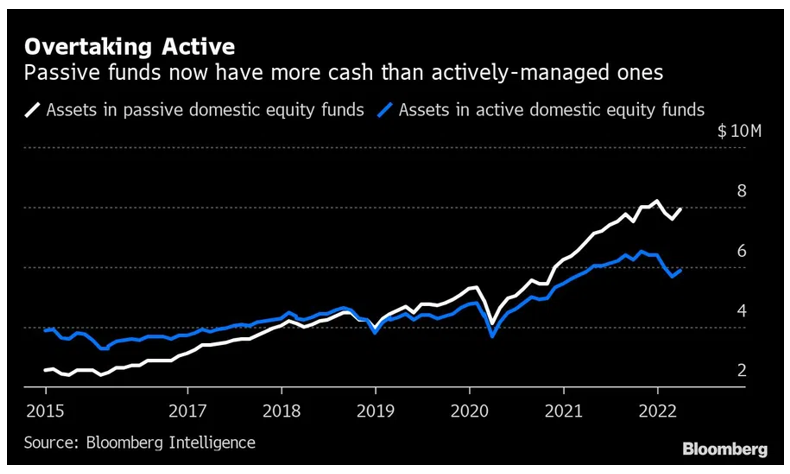
In Europe, where active managers generally performed less well in 2022 than in the US, active managers enjoy a larger market share but the direction of travel is the same as across the Atlantic. Across all asset classes globally, active strategies remain the dominant force, although the proportion managed in passive vehicles has doubled in ten years to 38% of AUM according to Morningstar[2].
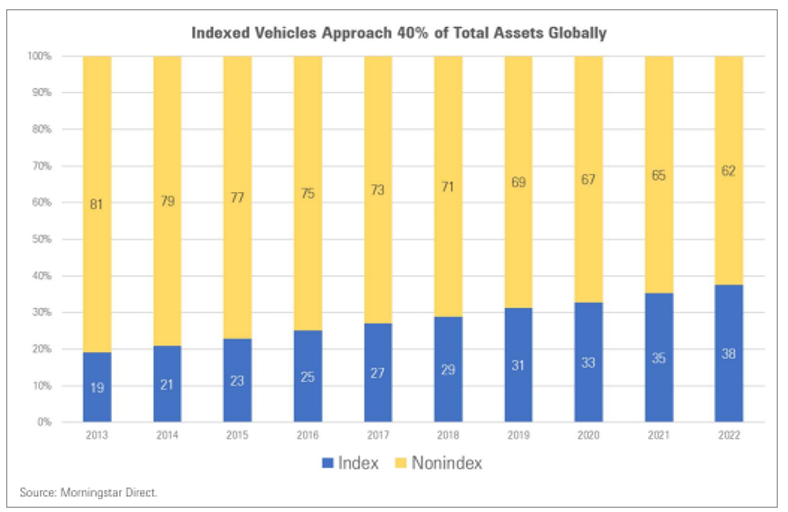
The prominence of index funds today is particularly remarkable considering they have only been in existence for around 50 years. All assets were managed actively until the 1970s when the invention of computers enabled greater scrutiny of money managers' performance. “A blindfolded monkey throwing darts at a newspaper's financial pages could select a portfolio that would do just as well as one carefully selected by experts.” was the conclusion of Princeton University professor Burton Malkiel in his 1973 bestselling book, A Random Walk Down Wall Street.
The world's first index fund was launched by Wells Fargo in 1971 and five years later Jack Bogle brought indexing to the masses when Vanguard introduced its first fund for retail investors attracted to the idea of paying lower fees and accepting “average” returns. Improvements in technology in the years since have helped passive managers to enter the mainstream by reducing trading costs and tracking error. Meanwhile, the growth of home computers and mobile technology have accelerated demand by making indices and funds ever-easier to monitor and trade.
As money has increasingly flowed into passive strategies, the number of different benchmarks for them to track has also grown exponentially. According to Bloomberg there are estimated to be around three million indices globally and over 10,000 exchange-traded funds (ETFs). This proliferation has seen the lines between passive and active styles blurred with the creation of customised benchmarks, active ETFs, smart-beta and an explosion of ESG-themed products.
Rage against the machines
The response of active managers to the passive attack has been similarly aggressive with new products launched targeting different market segments and multi-pronged attacks on the detriment index-based investing causes to capital market efficiency by distorting price discovery, channelling money to undeserving businesses and amplifying volatility.
These criticisms have arguably been weakened by lacklustre returns, with the majority of active managers underperforming their benchmarks after costs in recent years. The chart below lays bare the fortunes of US large-cap funds tracking the S&P 500 index – the largest and most followed global category – but the picture is similar across the size spectrum both in the US and internationally. Thankfully for stockpickers, 2022 saw an end to the long-running trend of below-par returns as poorly performing mega-cap growth companies helped the majority (62%) of active managers to beat the index[3]. 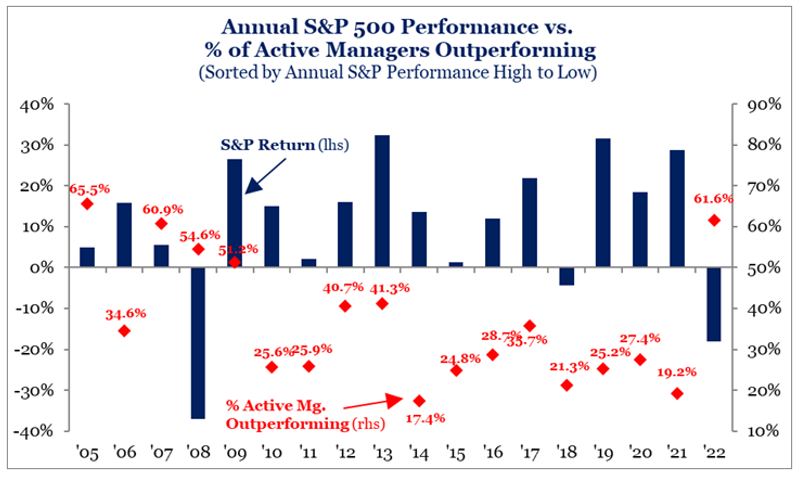
The chart above also highlights the 2008 financial crisis's pivotal role in shifting the momentum against active managers. As well as igniting the public's distrust of bankers and fund managers, it also sparked a decade-long bull market with stocks across the board buoyed by quantitative easing rather than fundamentals driving performance. With this period of financial stimulus now over and central banks raising interest rates to combat inflation, many commentators expect the momentum to change again in a more normalised investment environment.
Passive is no longer the response to good investment because the world is highly differentiated. Active management has a much better opportunity to outperform than it had in a world where the only issue was liquidity. In the world we're looking at, we're going to get massively different outcomes for different companies and sectors. - Mohamed El-Erian, Market Strategist and Chief Economic Adviser at Allianz, 2023 SKAGEN New Year Conference
Not all active managers are equal
Although actively managed funds on average have underperformed low-cost index funds after fees, this masks important differences between active funds (and subsequent returns). A highly influential 2006 study introduced the concept of Active Share to measure the extent to which a portfolio differs from its benchmark index[4]. The authors examined the performance of 2,740 US funds between 1980 and 2003 and concluded that while the average fund underperformed, those that deviated most from the index (Active Share > 80%) outperformed annually after fees. Less active funds underperformed by increasing amounts as they more closely resembled their respective benchmarks and diminishing alpha was eaten up by the fund manager's fees.
Economically, this means that stock selection as indicated by high Active Share is rewarded in the stock market, and the most aggressive stock pickers are able to add value to their investors even net of all expenses. - Cremers and Petajisto (2009)
Following the study's 2019 publication in an academic journal, Active Share has been widely adopted across the investment industry for portfolio analysis. Arguably its greatest use is to help identify 'closet indexers' – funds that claim to be active (and charge higher fees) but in reality hug the benchmark. Intuitively it is this group of funds – defined as those with an Active Share between 20% and 60% – that destroy the most value for clients and that regulations across Europe have since been introduced to address.
A follow-up study in 2013 by the same authors extended the observation period by six years to include the 2008 financial crisis and found similar results[5]. Meanwhile, 2016 research by Morningstar focusing on European-domiciled funds investing in large-caps from 2005 to 2015 found similar results across the Atlantic; funds in the top Active Share quintile delivered higher average benchmark-adjusted returns than less active ones[6].
A comprehensive investigation into closet indexing by the European Securities and Markets Authority (ESMA) found the same positive correlation between Active Share and performance in funds across the market cap spectrum. ESMA looked at 5,400 EU-domiciled funds investing in companies of all sizes between 2010 to 2018 and concluded: "not only do less active funds achieve worse performance, but they also tend to be almost as expensive as truly active funds"[7].
While broad consensus exists that active managers aren't all equal and those that hug the index are guaranteed to underperform after costs, the predictive power of Active Share alone is open to challenge. A high number is best viewed as a necessary rather than sufficient condition for alpha generation. Other portfolio characteristics improve an active manager's chances of success, as well as the markets in which they invest.
Portfolio power
Being different doesn't always mean being better when it comes to alpha generation as the wide-ranging performance of active managers both over time and between categories of Active Share demonstrate. So what, if any, are the portfolio characteristics of successful stock pickers beyond investing as far away from the index as possible?
In seeking to understand the drivers of consistent outperformance, studies have identified shared traits among the best performing active managers' portfolios. First, investing long-term has been shown to boost returns. Another consequence of advancements in technology and computing power is that market participants are increasingly short-termist. The rise of passive investing alongside algorithmic and high-frequency trading means that average holding periods have fallen from eight years in the 1960s to now less than six months[8].
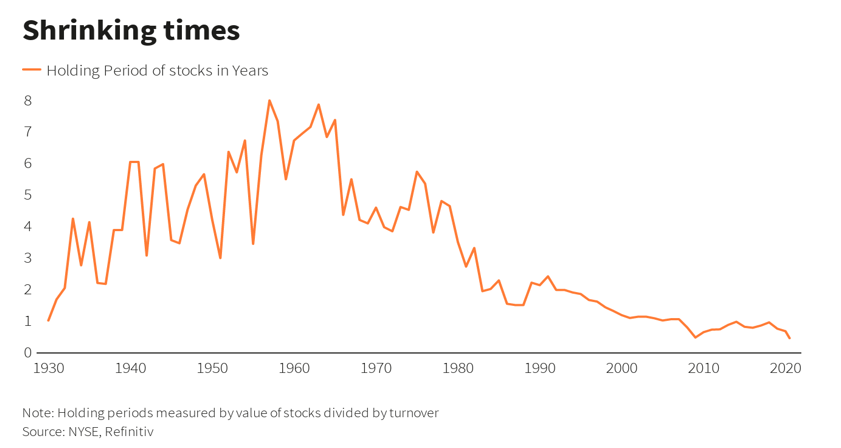
Ever-shorter holding periods create arbitrage opportunities for long-term investors who can exploit security mispricing that requires patience to correct while also benefitting from reduced trading costs. A 2014 study found that among high Active Share portfolios, those with holding periods over two years delivered the best returns[9]. The authors looked at 288 US mutual funds from 1990 and 2013 and found that the most active and patient funds generated alpha of 2.05% per annum net of fees.
Alongside having the conviction to hold stocks for a long time period, owning them in a concentrated portfolio has also been found to maximise value. Although conventional wisdom suggests that fund managers should diversify their portfolios widely to minimise risk, doing so inevitably makes the fund more index-like and increases trading costs, thereby reducing its potential to maximise risk-adjusted return. A positive relationship between conviction and performance was confirmed by a 2005 study of 1,771 actively managed US mutual funds between 1984 and 1999 which found that those with above-average concentration outperformed by an average 0.3% annually after costs[10].
These findings are supported by a 2021 study into fund managers' best ideas which found that the stocks most favoured by active managers outperformed the market, as well as their other holdings, by between 2.8% and 4.5%[11]. The researchers looked at US funds between 1993-2018 and found the results to be consistent across different benchmarks, risk models and definitions of best ideas.
These results present powerful evidence that the typical mutual fund manager can indeed pick stocks. The poor overall performance of mutual fund managers in the past is not due to a lack of stock-picking ability, but rather to institutional factors that encourage them to overdiversify, i.e. pick stocks beyond their best alpha-generating ideas. - Anton, Cohen and Polk, 2021
Stockpickers' markets
Active investors believe that stock markets are inefficient which creates opportunities for skilled stockpickers to generate out-sized returns. The concept of market efficiency was first explored by Nobel Laureate Eugene Fama in the 1960s and identifying dysfunctional markets which active managers can exploit has been the focus of considerable research ever since[12].
Active investors' chances of success increase when correlation – a measure of how stocks move in relation to one another – is low as this suggests that company-specific rather than macroeconomic news is driving returns. More important for stock pickers is dispersion – the extent to which stocks move in relation to the market average – with high dispersion indicative of a greater opportunity set to beat (and also underperform) the market. In 2022 stock dispersion among constituents of the S&P 500 index was its highest since 2009, creating the conditions for active managers to reap the rewards of successful stock selection.
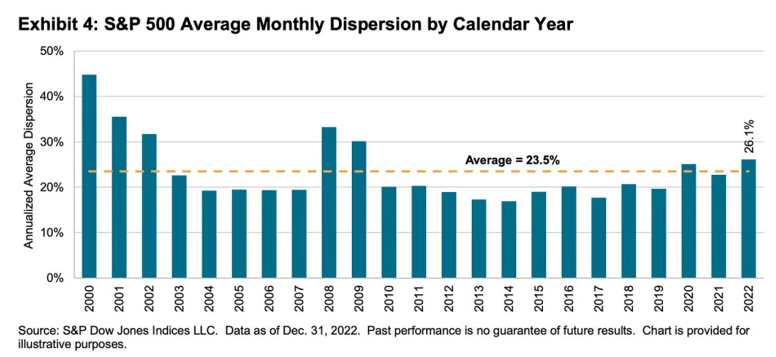
There are also segments of the stock market which function less efficiently than others where active managers can have greater possibilities to outperform. The growth of passive investing has distorted both ends of the company size spectrum, for example. With most indices market-cap weighted, the funds tracking them are tilted towards the largest stocks where valuations have become inflated – the average company size in the global index is over $20bn[13].
In addition, active funds – particularly larger ones and closet indexers – gravitate towards the largest stocks which means smaller companies receive less attention from investors and analysts. Compared to 1,357 large-cap companies globally, there are currently 6,256 small-caps – a huge universe that buy and sell-side analysts increasingly struggle to cover[14]. Whereas almost 90% of large-cap companies have more than 10 analyst recommendations and less than 4% are covered by five analysts or fewer, only 16% of small and mid-cap stocks have over 10 analyst recommendations and about two thirds have five or less[15].
A lack of research coverage and liquidity has created an inefficient market for smaller companies with valuations deeply discounted versus historic averages. Research in 2005 found that 780 active managers of US small–cap equity portfolios consistently and significantly outperformed the Russell 2000 index over a 20-year period, with the author concluding: "After taking into account survivorship bias, instant history bias, and a mild large–cap growth bias in the universe, we see the small-cap active management premium seems to have been significant and consistent over the periods"[16]. Petajisto similarly found that the positive effect of higher Active Share on fund performance was greatest among small-cap funds[17].
Emerging markets also tend to function less efficiently than developed ones as information can be harder to find and companies are followed by fewer analysts. Developing markets are also associated with higher geopolitical and macroeconomic uncertainty, making them more volatile than developed markets, which creates further opportunities for stockpickers to outperform.
A 2017 study into emerging market funds between 2009-2014 found a positive and significant relationship between Active Share and fund performance. The researchers examined 67 funds and found that around 70% outperformed the benchmark with the greatest alpha (+0.2% per month) generated by funds in the top quintile of Active Share.
"Emerging equity markets should offer some of the best opportunities for active managers because these markets are subject to greater political and economic risk than developed markets. Because of this relative market inefficiency, a skilled investor that has access to local information should be able to consistently outperform a non-informed, passive investor in these markets." – Grottesman and Morey, 2017
Meanwhile, analysis this year by Copley Fund Research of 278 emerging market funds found them to have generated cumulative 10-year alpha of 2.76% on average, with funds in the highest active category delivering the best relative performance (+3.76%) over this time. 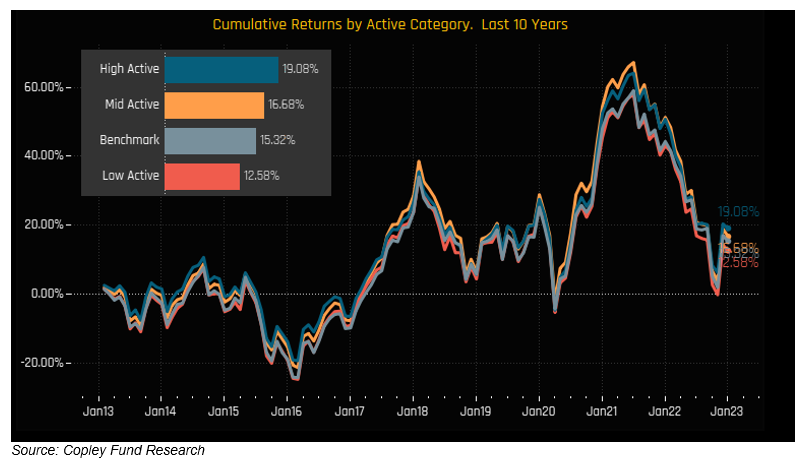
Passive pitfalls
Although in many ways passive investing is simpler than actively selecting individual stocks, it is not without risks. Passive investors have unmitigated exposure to the entire market they are tracking, which inevitably includes winners and losers. In 2022, the S&P 500 index fell nearly 20% despite the majority (58%) of stocks outperforming. The overall market decline was driven by a handful of large technology stocks de-rating (seven companies lost a combined $4,205 billion) with no hiding place for passive investors.
Despite last year's correction, index concentration risk remains high. The ten largest companies in the S&P 500 currently represent 28% of the benchmark with six coming from either the IT or Communication Services sectors. Market-cap weighted index funds allocate capital simply on the basis of company size and by continually over-weighting expensive shares while under-weighting cheap ones, they become self-fulfilling. With valuations – the most reliable predictor of future returns – still high for the largest companies, passive investors could well face further pain.
Active management, on the other hand, allows for the pre-emptive management of portfolio risk which can be particularly advantageous during periods of drawdown or volatility. As well as having the flexibility to react to changing conditions, using fundamental analysis to avoid the biggest stock market losers can be equally significant for portfolio returns as picking the winners.
Finally, there can be hidden risks associated with the structure of passive investment products. ETFs, for example, have experienced issues relating to the composition on an underlying index, how it is rebalanced or the liquidity of individual securities. The fees charged by passive products can also be a significant drag on performance, particularly in less developed markets where trading costs are often higher.
The Vanguard Emerging Markets Stock Index Fund, for example, lagged the MSCI EM Index by 28bps last year and by an average of 31bps annually over 3 years or nearly 1.0% cumulatively[18]. While active funds – particularly those with higher active share – have a decent chance to beat the index after fees, passive ones are designed to underperform to varying degrees.
SKAGEN's active agenda
Since formation three decades ago, SKAGEN has been a highly active fund manager whose investment philosophy is centred on value-based stockpicking. All of our portfolio managers invest bottom-up by selecting the companies they believe will deliver the most value for clients, irrespective of their inclusion or position in an index.
Our funds benefit from unconstrained mandates and their portfolios consistently have high Active Share over 90%, ranking them among the most active in the industry. We invest with conviction in our best ideas to create concentrated portfolios of typically less than 50 stocks, where the top ten holdings represent between a third and a half of assets.
Broad and flexible mandates also enable our portfolio managers to exploit market inefficencies that create valuation anomalies on behalf of our clients. These include global emerging markets (SKAGEN Kon-Tiki), global small and mid-caps (SKAGEN Focus) and global listed real estate (SKAGEN M²). Finally, we are long-term investors. Our funds have average holding periods over two years and several of our highest conviction positions have been in our portfolios for many years, sometimes decades (SKAGEN Global).
In line with the prevailing academic research outlined in this paper, this highly active approach has translated into strong fund performance, despite the headwinds for value investors in the ten-plus years following the global financial crisis. The majority of our five equity funds are ahead of their respective benchmarks over one and three years, as well as since the funds' were launched[19].
The next 30 years
The future of active management is likely to be shaped by three inter-linked factors: investor preferences, market conditions and technological developments. First, asset owners' demand for low cost passive investment solutions shows no signs of slowing. Research by ISS predicts that index funds will break through 50% market share next year in the US across all asset classes and reach 56% by the end of 2027[20].
For nimble active managers the continued growth of passive strategies could mean even greater opportunities to outperform, for example by exploiting the pricing bubbles created by market-cap weighted indices and nicher areas of the market which become increasingly inefficient and illiquid as capital is diverted towards more mainstream index-linked products.
Another important driver is investors' changing attitudes towards sustainability, particularly as wealth is transferred to younger generations with stronger ESG convictions. Alongside regulatory pressure, all asset managers will need to demonstrate the integration of ESG into their investment processes regardless of where they sit on the active-passive spectrum. If investors' current preference for engagement over divestment continues or strengthens then active managers could benefit from increased inflows at the expense of passive investors who tend to have a more exclusionary approach to sustainability.
Second, market conditions are seemingly improving for stockpickers as evidenced by their improving performance in 2022. The end to quantitative easing and a new era of higher interest rates should level the playing field for skilled stockpickers to outperform. This should drive flows from passive to active strategies, particularly if persistently higher inflation forces investors to seek market-beating returns to protect their savings and spending power in real terms.
At the same time, the lack of diversification in many indices remains high and the self-fulfilling nature of passive funds means that their investors are dangerously exposed to bubbles or further market corrections. A significant drawdown could see outflows from passive products at a similar rate to previous inflows and at the same time create huge opportunities (and accompanying inflows) for active managers.
Finally, the rise of artificial intelligence could be a major disrupter of the asset management industry in the years to come. Technology has undoubtably helped drive the rise of indexation and passive strategies over the last 30 years and is likely to lead further developments over future decades. In addition to the huge amounts of capital currently being poured into machine-learning, it will provide investors with increasingly sophisticated tools to help them identify investment opportunities and manage risk.
Several AI ETFs have been launched that seek to harness machine learning, language processing and sentiment analysis to drive returns, so far with mixed success. However, as AI technology improves and the sources of data it uses expand, better results could well follow.
In summary, the conclusion that active managers have not justified their fees is hard to ignore by looking at the average performance of stockpickers over recent years. However, the weight of academic research (and the performance of our own funds) shows that this masks very important differences between managers and those that are truly active have successfully generated alpha on a consistent basis. To further improve the odds of success, there are also a number of portfolio characteristics (concentrated funds, high conviction in best ideas and long holding periods) as well as markets (small-cap and emerging equities) where stockpickers can particularly flourish.
While recent market conditions have been unfavourable for stock picking, the changing macroeconomic environment of higher inflation and interest rates means that the short-term outlook is positive and longer-term industry trends remain supportive. Active managers, particularly the most skilled stock-pickers prepared to invest in less conventional markets, will have even more opportunities ahead to prove their worth.
[1] Source: Strategas Securities
[2] Morningstar Direct, Global Flows 2022: Outflows Follow 2021's Record Inflows, January 2023
[3] Source: Strategas Securities, 2023
[4] Cremers and Petajisto, How Active is Your Fund Manager? A New Measure That Predicts Performance, 2006
[5] Petajisto, Active Share and Mutual Fund Performance, 2013
[6] Morningstar, Active Share in European Equity Funds, 2016
[7] ESMA Working Paper, Closet indexing indicators and investor outcomes, 2020
[8] Source: Reuters, Buy, sell, repeat! No room for 'hold' in whipsawing markets, 2020
[9] Cremers and Pareek, Patient Capital Outperformance: The Investment Skill of High Active Share Managers Who Trade Infrequently, 2015
[10] Kacperczyk, Sialm, and Zheng, "On the Industry Concentration of Actively Managed Equity Mutual Funds", 2005.
[11] Anton, Cohen and Polk, Best Ideas, 2021
[12] Fama, Efficient Capital Markets: A Review of Theory and Empirical Work, 1969
[13] MSCI All Country World Index as at 31/01/2023
[14] Source: MSCI. MSCI ACWI Small Cap Index vs. MSCI ACWI Large Cap Index, as at 31/03/23
[15] Source: Bloomberg. Small-cap: €300 million - €2 billion; Mid-cap: €2 billion - and EUR 10 billion, while anything over EUR 10 billion is large-cap
[16] Allen, The Active Management Premium in Small-Cap U.S. Equities, 2005
[17] Petajisto, Active Share and Mutual Fund Performance,, 2013
[18] Source: Vanguard, as at 31/12/2022
[19] As at 31/03/2023, net of fees
[20] Source: For Active Managers, AUM a Weakening Indicator of Financial Success, January 2023




